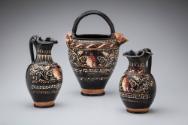Wine Pail (Situla) with Amazon Head and Theatrical Masks
Wine Pail (Situla) with Amazon Head and Theatrical Masks
Artist
Toledo Painter
(Greek)
Place of OriginItaly, Apulia, perhaps Ruvo di Puglia
Dateabout 330-320 BCE
DimensionsMax Dimensions: 12 1/4 × 8 3/4 × 6 3/4 in. (31.1 × 22.2 × 17.1 cm)
Diam (Vessel): 6 1/2 in. (16.5 cm)
Foot Diam: 3 5/8 in. (9.2 cm)
H (Vessel without handle): 8 3/8 in. (21.3 cm)
Diam (Vessel): 6 1/2 in. (16.5 cm)
Foot Diam: 3 5/8 in. (9.2 cm)
H (Vessel without handle): 8 3/8 in. (21.3 cm)
MediumWheel-thrown earthenware with polychrome slip decoration and molded, applied masks.
ClassificationCeramics
Credit LinePurchased with funds from the Libbey Endowment, Gift of Edward Drummond Libbey
Object number
1973.7
On View
Toledo Museum of Art (2445 Monroe Street), Gallery, 02, Classic
DescriptionThis 30.8 cm (12 1/8 in.) tall situla, or pail, served as the centerpiece of a wine set and remains largely intact, with only minor color losses. Made in the Gnathia technique, it imitates a metal prototype, complete with a movable handle. One side depicts the head of an Amazon in a Phrygian cap framed by decorative borders—egg and dot, zigzag, meander, and laurel wreath—matching the imagery on the set’s companion oinochoai.
The opposite side, which would face the user while pouring, features grape clusters and an ivy garland suspended from an egg and dot band. A molded satyr mask forms the spout, with a built-in strainer inside the mouth, while a pappasilenos mask secures the handle at the back. The interior is fully glazed.
Label TextThis striking situla, or wine pail, was the centerpiece of a luxury drinking set from Magna Graecia (“Great Greece”). Starting in the 8th century BCE, Greeks colonized southern Italy, living and trading with local Italic peoples. This vessel, which imitates a more expensive bronze pail, was made for an elite customer in this mixed society, where Greek customs were adopted and adapted for local use. This situla and its two matching jugs (1973.5 and 1973.6) are the "namesake vases" of the Toledo Painter, an ancient artist whose unique, high-quality style was first identified from this very set.
The vessel is covered in imagery related to Dionysos, the god of wine and theater. A vivid mask of a satyr forms the spout (with a strainer hidden inside), and his aged father, Pappasilenos, forms the handle. In Magna Graecia, Dionysos was also worshipped as a god who triumphed over the underworld. This vase was used to mix wine and water at a symposium, or drinking party, but its ultimate purpose was funerary. Placed in an elite tomb, its Dionysiac themes and the ambiguous Phrygian head on its side offered a powerful, shared hope for rebirth and a joyous afterlife for both Greek and Italic owners.
Published ReferencesWittmann, Otto, ed., "Treasures for Toledo," Toledo Museum of Art Museum News, vol. 19, nos. 2 and 3, 1976, p. 48, repr.Green, J.R., "Gnathia Vases by The Toledo Painter," Toledo Museum of Art Museum News, vol. 22, no. 2, 1980, pp. 26-36, figs. 2, 3, 6, 7.
Schauenburg, Konrad, “Zu unteritalischen Situlen,” Archäologischer Anzeiger, 1981, p. 464-467, fig. 7.
Luckner, Kurt T., The Art of South Italy: Vases from Magna Graecia, Richmond, 1982, p. 269, no. 128.
Boulter, Cedric G., and Kurt T. Luckner, Corpus Vasorum Antiquorum, Toledo Museum of Art, fasc. 2 [U.S.A., fasc. 20], Mainz, 1984, pp.26-7, pls. 109, 110.1-2. Kossatz-Deissmann, Annelise. "Eine Neue Phrygerkoph-Situla des Toledo-Malers," Archaölogisches Anzeiger, 1990, pp. 505-520, figs. 40, 43.
Exhibition History"The Art of South Italy: Vases from Magna Graecia" The Virginia Museum of Fine Arts, Richmond (May 12-Aug. 8, 1982); Philbrook Art Center, Tulsa (Nov. 20, 1982 - Jan. 9, 1983); The Detroit Institute of Arts (Feb. 7 - April 10, 1983); no. 130.Probably second quarter of the 1st century
Probably second quarter of the 1st century
1st century CE
325-300 BCE
1st century BCE - 3rd century CE

Membership
Become a TMA member today
Support TMA
Help support the TMA mission


















